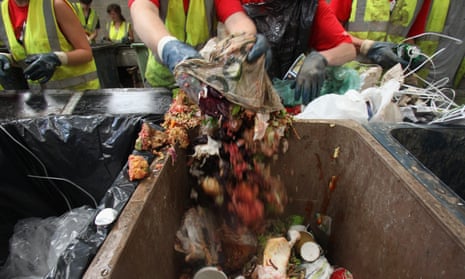In September, the US government announced the first ever national goal to reduce America’s food waste, giving an extra push to a movement on the part of big brands to cut down on waste.
The US Department of Agriculture (USDA) and the Environmental Protection Agency (EPA) – in partnership with charities and the private sector – is targeting a 50% cut in edible food waste by 2030.
More than 133bn pounds of food is thrown away each year in the US, accounting for roughly one third of the nation’s food supply, according to the USDA. The cost to the global economy is about $750bn a year. Food waste is also the single biggest component of the country’s landfills, where it produces methane, one of the most potent greenhouse gases. It also carries a social cost: the USDA estimates that reducing food waste by just 15% would feed roughly 25 million Americans each year, more than half of those currently living in food-insecure households.
Companies are big contributors to food waste. In 2014, food manufacturers generated over 7bn pounds of it, while grocery stores produced 10 pounds of waste for every $1000 consumers spent, according to a study by industry trade group Food Waste Reduction Alliance.
The food industry and advocacy groups applauded the announcement, highlighting the need for a collaborative effort to tackle the issue.
“It’s a concrete indication of a real commitment on the part of the administration,” said Dana Gunders, staff scientist at advocacy group Natural Resources Defense Council and author of the Waste-Free Kitchen Handbook: “The goal is very aggressive – it could have been 10% or 30%, so they really went all the way by committing to halving the amount of food waste produced.”
Meghan Stasz, senior director of sustainability at the Grocery Manufacturers Association, said there was “no one single bullet that’s going to solve food waste, in the US and globally.” She said partnerships between companies and with outside groups will be critical.
The USDA goal is voluntary, at least for now. But there’s an incentive for companies to cut down on food waste, what Stasz calls a “perfect triple bottom line issue”. Participating means they save money, reduce their environmental footprint and help communities in need.
Recognizing this, businesses have already started to set ambitious goals to reduce waste. Over 400 brands, including consumer goods giant Unilever and food manufacturer Kellogg, committed in July to slashing food waste in their retail and manufacturing operations by half over the next decade.
“As a global food company, Kellogg believes we have a significant role to play in helping to end hunger, achieve food security, improve nutrition and promote sustainable agriculture,” Kellogg spokeswoman Kris Charles told the Guardian. “We support the USDA and EPA in their efforts to launch the nation’s first food waste reduction goals and are committed to doing our part”.
Kellogg is reducing its waste at various points along its supply chain, including onfarms and during the manufacturing process. For instance, the company is developing agricultural programs with smallholder farmers in countries like India, South Africa and Bangladesh, to ensure more of the food that’s grown is consumed. Kellogg is also using food waste created during manufacturing to feed the hungry, and has committed to providing 1bn in snacks to needy communities around the world by 2016.
In May, food and beverage brand Nestlé launched a similar initiative to cut food waste, building on its goal to achieve zero waste to landfill across manufacturing sites by 2020.
Nestlé USA spokeswoman Edie Burge said the company supports the USDA’s goal. “Our efforts include responsible sourcing and educating our consumers about food waste” Burge said. The company is also working with the World Resources Institute to develop a global standard to measure food loss in the supply chain.
Measurement is key, according to Gunders. “Really understanding what’s being wasted and when can help you understand how to find solutions,” Gunders said. “It’s been surprising to me how many food companies don’t always know how much gets wasted.”
There are a number of resources available to help businesses track their waste, such as LeanPath, software that enables restaurants to monitor food waste. The digital tool provides the financial value of the food item to be tossedand the cost if it were wasted daily for a year.
Going forward, companies will need to get creative and find new uses for waste, said Elliott Maltby, an expert on green business and designer of the first community farm on New York City public housing property. In cities like New York, for example, restaurants are selling or donating food waste to urban farms to create compost, bioenergy and natural fertilizers. For companies that make and process food, “significant retooling is underway”, Maltby said.
“Everything from shopping options to bulk sales to cooking methods and packaging and labeling will be affected,” Maltby said. “We will see dramatic innovation by some businesses.”

Comments (…)
Sign in or create your Guardian account to join the discussion